Answered step by step
Verified Expert Solution
Question
1 Approved Answer
Read the case study and respond to the following questions What are the characteristics of the smartphone industry? , What are Samsungs key strengths? What
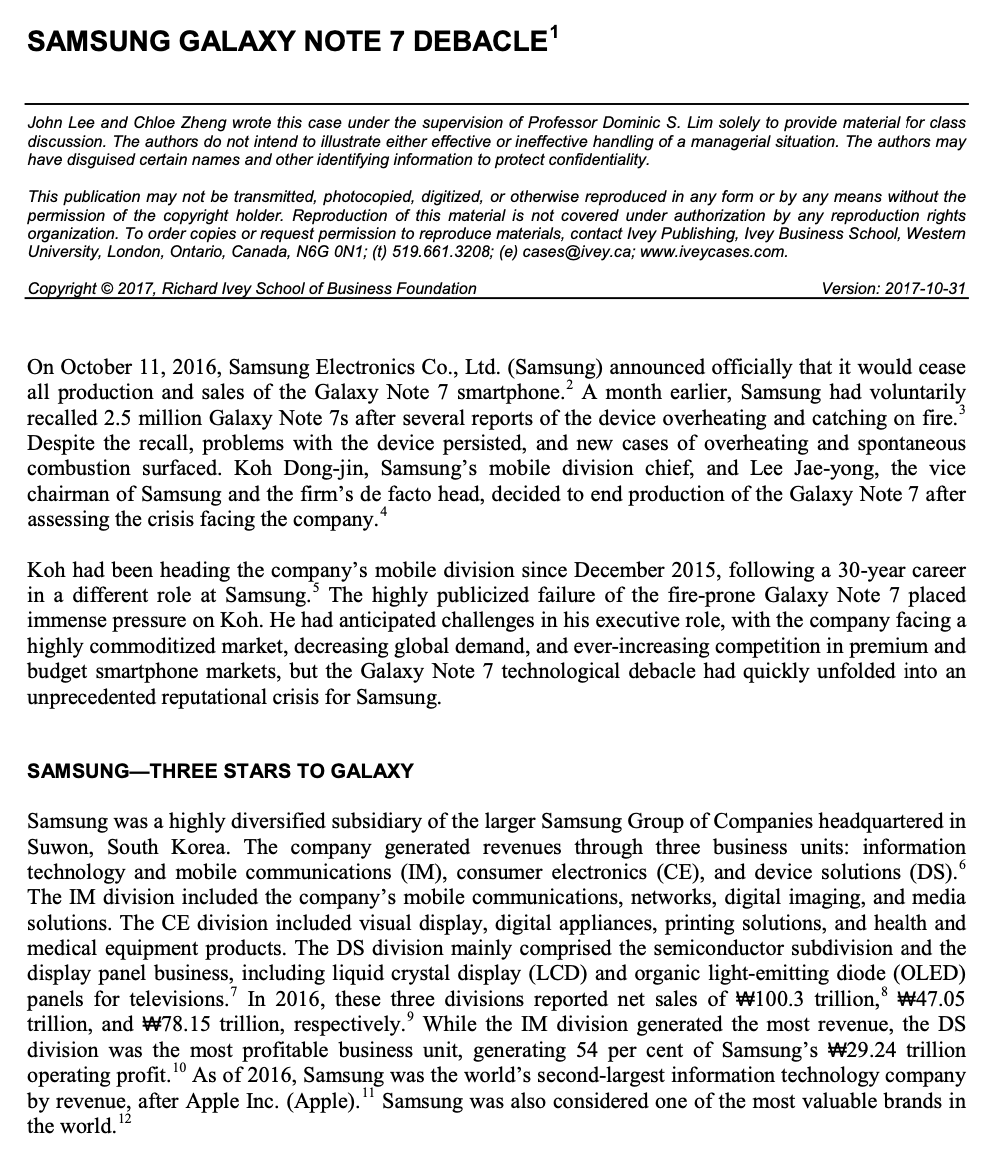
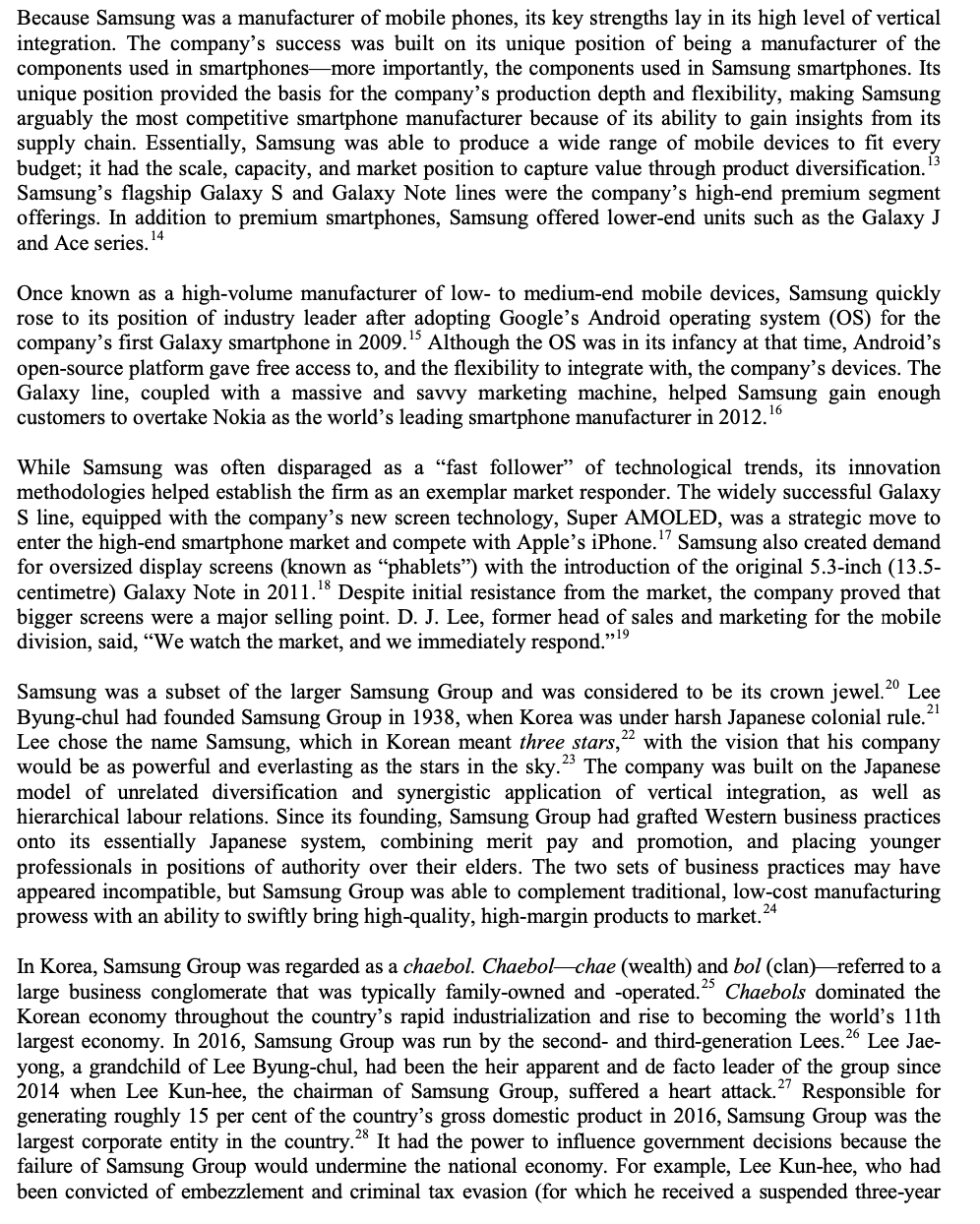
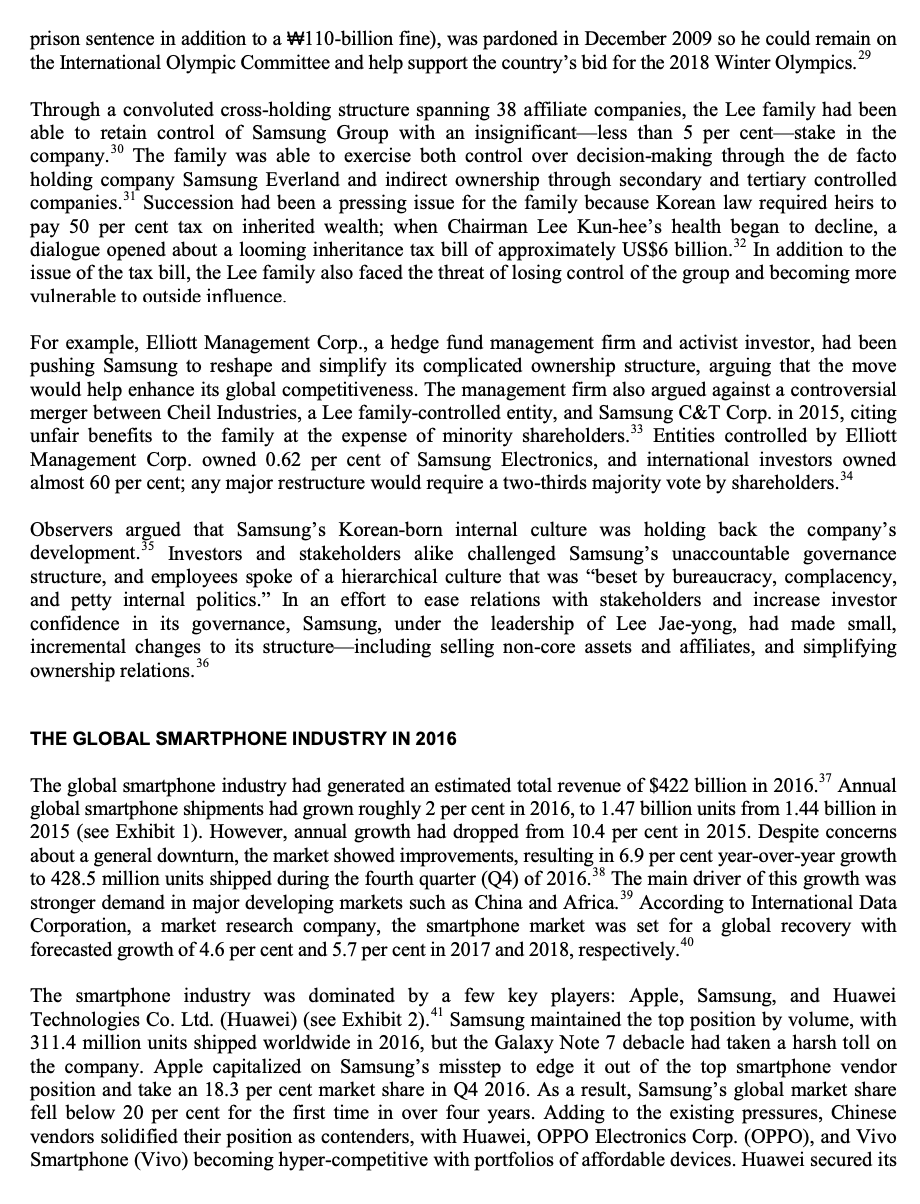

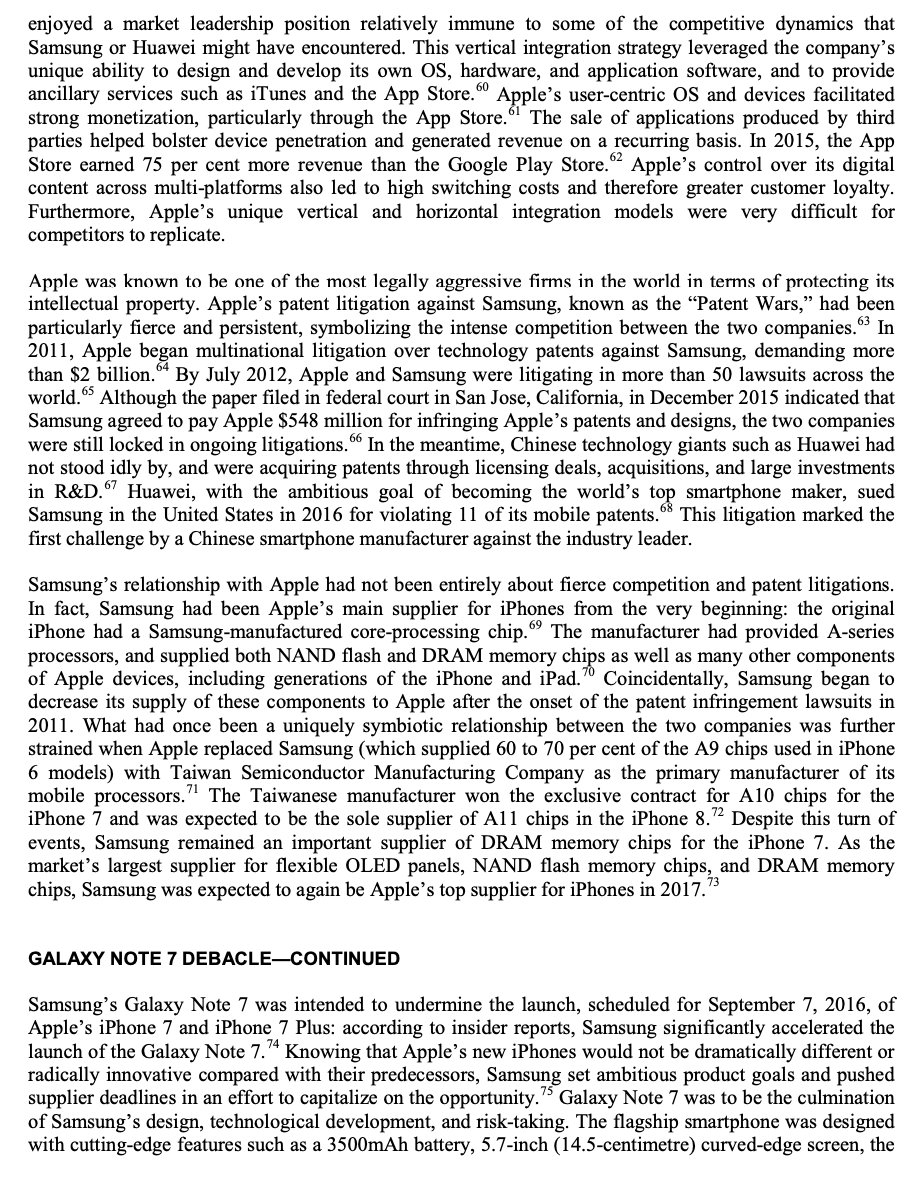

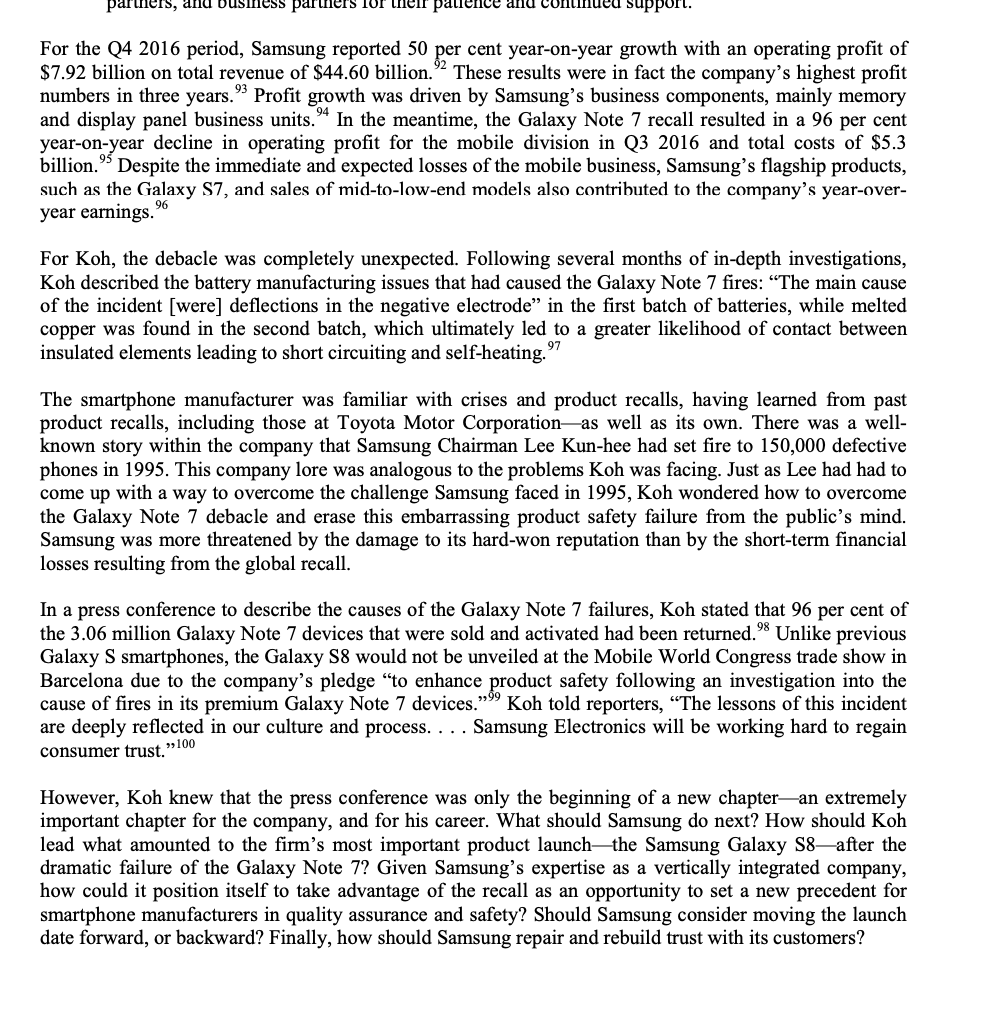 Read the case study and respond to the following questions
Read the case study and respond to the following questions
What are the characteristics of the smartphone industry? ,
What are Samsungs key strengths? What is the nature of the product
quality problem faced by Samsung? Which of Samsungs organizational
practices contributed to the problem?
SAMSUNG GALAXY NOTE 7 DEBACLE 1 John Lee and Chloe Zheng wrote this case under the supervision of Professor Dominic S. Lim solely to provide material for class discussion. The authors do not intend to illustrate either effective or ineffective handling of a managerial situation. The authors may have disguised certain names and other identifying information to protect confidentiality. This publication may not be transmitted, photocopied, digitized, or otherwise reproduced in any form or by any means without the permission of the copyright holder. Reproduction of this material is not covered under authorization by any reproduction rights organization. To order copies or request permission to reproduce materials, contact Ivey Publishing, Ivey Business School, Western University, London, Ontario, Canada, N6G ON1; (t) 519.661.3208; (e) cases@ivey.ca; www.iveycases.com. Copyright @ 2017, Richard Ivey School of Business Foundation Version: 2017-10-31 On October 11, 2016, Samsung Electronics Co., Ltd. (Samsung) announced officially that it would cease all production and sales of the Galaxy Note 7 smartphone. 2 A month earlier, Samsung had voluntarily recalled 2.5 million Galaxy Note 7 s after several reports of the device overheating and catching on fire. 3 Despite the recall, problems with the device persisted, and new cases of overheating and spontaneous combustion surfaced. Koh Dong-jin, Samsung's mobile division chief, and Lee Jae-yong, the vice chairman of Samsung and the firm's de facto head, decided to end production of the Galaxy Note 7 after assessing the crisis facing the company. 4 Koh had been heading the company's mobile division since December 2015, following a 30-year career in a different role at Samsung. 5 The highly publicized failure of the fire-prone Galaxy Note 7 placed immense pressure on Koh. He had anticipated challenges in his executive role, with the company facing a highly commoditized market, decreasing global demand, and ever-increasing competition in premium and budget smartphone markets, but the Galaxy Note 7 technological debacle had quickly unfolded into an unprecedented reputational crisis for Samsung. SAMSUNG-THREE STARS TO GALAXY Samsung was a highly diversified subsidiary of the larger Samsung Group of Companies headquartered in Suwon, South Korea. The company generated revenues through three business units: information technology and mobile communications (IM), consumer electronics (CE), and device solutions (DS). 6 The IM division included the company's mobile communications, networks, digital imaging, and media solutions. The CE division included visual display, digital appliances, printing solutions, and health and medical equipment products. The DS division mainly comprised the semiconductor subdivision and the display panel business, including liquid crystal display (LCD) and organic light-emitting diode (OLED) panels for televisions. 7 In 2016 , these three divisions reported net sales of 100.3 trillion, 8#47.05 trillion, and 78.15 trillion, respectively. 9 While the IM division generated the most revenue, the DS division was the most profitable business unit, generating 54 per cent of Samsung's 29.24 trillion operating profit. 10 As of 2016, Samsung was the world's second-largest information technology company by revenue, after Apple Inc. (Apple). 11 Samsung was also considered one of the most valuable brands in the world. 12 Because Samsung was a manufacturer of mobile phones, its key strengths lay in its high level of vertical integration. The company's success was built on its unique position of being a manufacturer of the components used in smartphones-more importantly, the components used in Samsung smartphones. Its unique position provided the basis for the company's production depth and flexibility, making Samsung arguably the most competitive smartphone manufacturer because of its ability to gain insights from its supply chain. Essentially, Samsung was able to produce a wide range of mobile devices to fit every budget; it had the scale, capacity, and market position to capture value through product diversification. 3 Samsung's flagship Galaxy S and Galaxy Note lines were the company's high-end premium segment offerings. In addition to premium smartphones, Samsung offered lower-end units such as the Galaxy J and Ace series. 14 Once known as a high-volume manufacturer of low- to medium-end mobile devices, Samsung quickly rose to its position of industry leader after adopting Google's Android operating system (OS) for the company's first Galaxy smartphone in 2009.15 Although the OS was in its infancy at that time, Android's open-source platform gave free access to, and the flexibility to integrate with, the company's devices. The Galaxy line, coupled with a massive and savvy marketing machine, helped Samsung gain enough customers to overtake Nokia as the world's leading smartphone manufacturer in 2012.16 While Samsung was often disparaged as a "fast follower" of technological trends, its innovation methodologies helped establish the firm as an exemplar market responder. The widely successful Galaxy S line, equipped with the company's new screen technology, Super AMOLED, was a strategic move to enter the high-end smartphone market and compete with Apple's iPhone. 17 Samsung also created demand for oversized display screens (known as "phablets") with the introduction of the original 5.3-inch (13.5centimetre) Galaxy Note in 2011. 18 Despite initial resistance from the market, the company proved that bigger screens were a major selling point. D. J. Lee, former head of sales and marketing for the mobile division, said, "We watch the market, and we immediately respond." 19 Samsung was a subset of the larger Samsung Group and was considered to be its crown jewel. 20 Lee Byung-chul had founded Samsung Group in 1938, when Korea was under harsh Japanese colonial rule. 21 Lee chose the name Samsung, which in Korean meant three stars, 22 with the vision that his company would be as powerful and everlasting as the stars in the sky. 23 The company was built on the Japanese model of unrelated diversification and synergistic application of vertical integration, as well as hierarchical labour relations. Since its founding, Samsung Group had grafted Western business practices onto its essentially Japanese system, combining merit pay and promotion, and placing younger professionals in positions of authority over their elders. The two sets of business practices may have appeared incompatible, but Samsung Group was able to complement traditional, low-cost manufacturing prowess with an ability to swiftly bring high-quality, high-margin products to market. 24 In Korea, Samsung Group was regarded as a chaebol. Chaebol - chae (wealth) and bol (clan)-referred to a large business conglomerate that was typically family-owned and -operated. 25 Chaebols dominated the Korean economy throughout the country's rapid industrialization and rise to becoming the world's 11th largest economy. In 2016, Samsung Group was run by the second- and third-generation Lees. 26 Lee Jaeyong, a grandchild of Lee Byung-chul, had been the heir apparent and de facto leader of the group since 2014 when Lee Kun-hee, the chairman of Samsung Group, suffered a heart attack. 27 Responsible for generating roughly 15 per cent of the country's gross domestic product in 2016, Samsung Group was the largest corporate entity in the country. 28 It had the power to influence government decisions because the failure of Samsung Group would undermine the national economy. For example, Lee Kun-hee, who had been convicted of embezzlement and criminal tax evasion (for which he received a suspended three-year prison sentence in addition to a 110-billion fine), was pardoned in December 2009 so he could remain on the International Olympic Committee and help support the country's bid for the 2018 Winter Olympics. 29 Through a convoluted cross-holding structure spanning 38 affiliate companies, the Lee family had been able to retain control of Samsung Group with an insignificant-less than 5 per cent-stake in the company. 30 The family was able to exercise both control over decision-making through the de facto holding company Samsung Everland and indirect ownership through secondary and tertiary controlled companies. 31 Succession had been a pressing issue for the family because Korean law required heirs to pay 50 per cent tax on inherited wealth; when Chairman Lee Kun-hee's health began to decline, a dialogue opened about a looming inheritance tax bill of approximately US $6 billion. 32 In addition to the issue of the tax bill, the Lee family also faced the threat of losing control of the group and becoming more vulnerable to outside influence. For example, Elliott Management Corp., a hedge fund management firm and activist investor, had been pushing Samsung to reshape and simplify its complicated ownership structure, arguing that the move would help enhance its global competitiveness. The management firm also argued against a controversial merger between Cheil Industries, a Lee family-controlled entity, and Samsung C\&T Corp. in 2015, citing unfair benefits to the family at the expense of minority shareholders. 33 Entities controlled by Elliott Management Corp. owned 0.62 per cent of Samsung Electronics, and international investors owned almost 60 per cent; any major restructure would require a two-thirds majority vote by shareholders. 34 Observers argued that Samsung's Korean-born internal culture was holding back the company's development. 35 Investors and stakeholders alike challenged Samsung's unaccountable governance structure, and employees spoke of a hierarchical culture that was "beset by bureaucracy, complacency, and petty internal politics." In an effort to ease relations with stakeholders and increase investor confidence in its governance, Samsung, under the leadership of Lee Jae-yong, had made small, incremental changes to its structure - including selling non-core assets and affiliates, and simplifying ownership relations. 36 THE GLOBAL SMARTPHONE INDUSTRY IN 2016 The global smartphone industry had generated an estimated total revenue of $422 billion in 2016.37 Annual global smartphone shipments had grown roughly 2 per cent in 2016, to 1.47 billion units from 1.44 billion in 2015 (see Exhibit 1). However, annual growth had dropped from 10.4 per cent in 2015. Despite concerns about a general downturn, the market showed improvements, resulting in 6.9 per cent year-over-year growth to 428.5 million units shipped during the fourth quarter (Q4) of 2016.38 The main driver of this growth was stronger demand in major developing markets such as China and Africa. 39 According to International Data Corporation, a market research company, the smartphone market was set for a global recovery with forecasted growth of 4.6 per cent and 5.7 per cent in 2017 and 2018, respectively. 4 The smartphone industry was dominated by a few key players: Apple, Samsung, and Huawei Technologies Co. Ltd. (Huawei) (see Exhibit 2). 41 Samsung maintained the top position by volume, with 311.4 million units shipped worldwide in 2016, but the Galaxy Note 7 debacle had taken a harsh toll on the company. Apple capitalized on Samsung's misstep to edge it out of the top smartphone vendor position and take an 18.3 per cent market share in Q4 2016. As a result, Samsung's global market share fell below 20 per cent for the first time in over four years. Adding to the existing pressures, Chinese vendors solidified their position as contenders, with Huawei, OPPO Electronics Corp. (OPPO), and Vivo Smartphone (Vivo) becoming hyper-competitive with portfolios of affordable devices. Huawei secured its position as the third-largest smartphone vendor with its Q4 2016 results of a 10.6 per cent market share, marking the first time a Chinese-based manufacturer had captured a double-digit market share. 42 In the same quarter, OPPO and Vivo both achieved more than 100 per cent year-over-year growth. And while OPPO and Vivo had marketed aggressively in Asia, Huawei had accelerated its performance overseas, including in Western Europe, with improved smartphone designs, more sophisticated marketing, and deeper retail distribution. 43 Growth in the smartphone industry had become reliant on replacing existing handsets, especially in mature markets such as North America, Western Europe, Japan, and the Asia/Pacific region where high adoption rates had reduced the pool of first-time buyers. This growth was further challenged as life cycles for premium smartphones increased to 2.5 years. 44 Consumers remained satisfied with the advanced features of their earlier-generation flagship smartphones, which stood up well to more recent devices. 45 On the other hand, emerging markets were expected to fuel growth of the smartphone industry as the average selling price of smartphones fell and product offerings increased. 46 This market progression had diminished the differentiation between premium devices and budget alternatives. Accordingly, manufacturers were pressured to either invest in new technologies to encourage consumers to upgrade their existing smartphones, or provide competitive pricing. 47 Apple's research and development (R\&D) expenditures were $8.1 billion, compared with Samsung's $12.8 billion investment in 2015.48 China's Huawei reportedly spent approximately $8.7 billion on R\&D in 2015.49 In the third quarter (Q3) of 2016, the Android OS had a global smartphone market share of 86.8 per cent, compared with Apple iOS's 12.5 per cent. 50 Woody Oh of Strategy Analytics commented, "Android's leadership of the global smartphone market looks unassailable at the moment. Its low-cost services and user-friendly software remain attractive to hardware makers, operators, and consumers worldwide." On the other hand, Android was an open platform adopted by multiple major manufacturers, making it much more fragmented and competitive. 51 Google, the software developer of Android, entered the smartphone hardware business in Q4 2016 with its Pixel and Pixel XL Android phones. Google's flagship smartphones boasted features to compete with Apple's iPhone 7, with a Siri-like virtual assistant, a 12megapixel camera featuring Google's superlative image processing, and a level of hardware and software optimization not seen in any previous Android smartphone (see Exhibit 3)52 APPLE VERSUS SAMSUNG Apple, based in Cupertino, California, was the technology giant that designed, developed, and sold computer software, online services, and consumer electronics - including the iconic iPhone. 53 Apple was the most valuable company in the world, with a market capitalization of $678 billion, and had been ranked the world's most valuable brand every year since 2012.54 It was the leading competitor in the premium smartphone market, commanding high average selling prices and catering to a loyal base of high-value consumers. 55 While Samsung was the leading global manufacturer of smartphones by volume, Apple was the most profitable smartphone vendor (see Exhibit 4). Apple had captured 91 per cent of profits in Q3 2016, owing to increased sales of its iPhone 7 and iPhone 7 Plus, and partly helped by Samsung's Galaxy Note 7 debacle. 56 The company reported $46.85 billion in sales in Q4 2016, up from $42.36 billion in Q3 2016. Approximately 60 per cent of the company's revenue was generated by iPhone sales. 57 Apple's most successful product was the iPhone, which, at the time of its launch in 2007, was effectively the first mobile phone with a touch-screen interface. The company had gone from selling some 1.4 million units in its first year on the market to selling more than 500 million units worldwide between 2007 and 2014. 58 Apple's competitive advantage was the company's proprietary iOS operation system, which integrated the user experience across all its devices. 59 Apple, by virtue of its closed iOS ecosystem, enjoyed a market leadership position relatively immune to some of the competitive dynamics that Samsung or Huawei might have encountered. This vertical integration strategy leveraged the company's unique ability to design and develop its own OS, hardware, and application software, and to provide ancillary services such as iTunes and the App Store. 60 Apple's user-centric OS and devices facilitated strong monetization, particularly through the App Store. 61 The sale of applications produced by third parties helped bolster device penetration and generated revenue on a recurring basis. In 2015, the App Store earned 75 per cent more revenue than the Google Play Store. 62 Apple's control over its digital content across multi-platforms also led to high switching costs and therefore greater customer loyalty. Furthermore, Apple's unique vertical and horizontal integration models were very difficult for competitors to replicate. Apple was known to be one of the most legally aggressive firms in the world in terms of protecting its intellectual property. Apple's patent litigation against Samsung, known as the "Patent Wars," had been particularly fierce and persistent, symbolizing the intense competition between the two companies. 63 In 2011, Apple began multinational litigation over technology patents against Samsung, demanding more than $2 billion. 64 By July 2012, Apple and Samsung were litigating in more than 50 lawsuits across the world. 65 Although the paper filed in federal court in San Jose, California, in December 2015 indicated that Samsung agreed to pay Apple $548 million for infringing Apple's patents and designs, the two companies were still locked in ongoing litigations. 66 In the meantime, Chinese technology giants such as Huawei had not stood idly by, and were acquiring patents through licensing deals, acquisitions, and large investments in R\&D. 67 Huawei, with the ambitious goal of becoming the world's top smartphone maker, sued Samsung in the United States in 2016 for violating 11 of its mobile patents. 68 This litigation marked the first challenge by a Chinese smartphone manufacturer against the industry leader. Samsung's relationship with Apple had not been entirely about fierce competition and patent litigations. In fact, Samsung had been Apple's main supplier for iPhones from the very beginning: the original iPhone had a Samsung-manufactured core-processing chip. 69 The manufacturer had provided A-series processors, and supplied both NAND flash and DRAM memory chips as well as many other components of Apple devices, including generations of the iPhone and iPad. 70 Coincidentally, Samsung began to decrease its supply of these components to Apple after the onset of the patent infringement lawsuits in 2011. What had once been a uniquely symbiotic relationship between the two companies was further strained when Apple replaced Samsung (which supplied 60 to 70 per cent of the A9 chips used in iPhone 6 models) with Taiwan Semiconductor Manufacturing Company as the primary manufacturer of its mobile processors. 71 The Taiwanese manufacturer won the exclusive contract for A10 chips for the iPhone 7 and was expected to be the sole supplier of A11 chips in the iPhone 8.72 Despite this turn of events, Samsung remained an important supplier of DRAM memory chips for the iPhone 7. As the market's largest supplier for flexible OLED panels, NAND flash memory chips, and DRAM memory chips, Samsung was expected to again be Apple's top supplier for iPhones in 2017..73 GALAXY NOTE 7 DEBACLE-CONTINUED Samsung's Galaxy Note 7 was intended to undermine the launch, scheduled for September 7, 2016, of Apple's iPhone 7 and iPhone 7 Plus: according to insider reports, Samsung significantly accelerated the launch of the Galaxy Note 7.74 Knowing that Apple's new iPhones would not be dramatically different or radically innovative compared with their predecessors, Samsung set ambitious product goals and pushed supplier deadlines in an effort to capitalize on the opportunity. 75 Galaxy Note 7 was to be the culmination of Samsung's design, technological development, and risk-taking. The flagship smartphone was designed with cutting-edge features such as a 3500mAh battery, 5.7-inch (14.5-centimetre) curved-edge screen, the S Pen, water and dust resistance (certified IP68 for dust and water resistance, compared with iPhone's IP67), 76 Super AMOLED panel, wireless charging, iris-recognition security, and a 3.5mm phono headphone jack..77 The Galaxy Note 7 was positively received, and demand for the phone was better than expected. 78 In a public statement, a Samsung representative said, "We appreciate the strong demand and positive response to the Galaxy Note 7 from consumers across the globe. As pre-order results for the Galaxy Note 7 have far exceeded our estimates, its release date in some markets has been adjusted., 79 Initial reviews of the Galaxy Note 7 were glowing: a Time magazine article titled, "Samsung's Galaxy Note 7 Is a Worthy Challenger to the iPhone," rated the Galaxy Note 7 four and a half out of five stars, compared with iPhone 7's four stars. 80 Forbes columnist Ewan Spence commented that the Galaxy Note 7 was the smartphone of 2016 and the contender for the top step - in an article published after the global recall. 81 Sadly, the Galaxy Note 7 had a fatal flaw, and even initial praise and strong reception of the device could not save it. 82 On September 15, 2016, immediately after the emergence of reports of overheating incidents, Samsung voluntarily recalled 2.5 million Galaxy Note 7s (see Exhibit 5). 83 The problem was initially attributed to a battery manufacturing error that put pressure on plates within the battery cells, bringing the negative and positive poles into contact and thus creating excessive heat, causing the battery to explode 84 In response, the company hastily implemented a replacement Galaxy Note 7. Samsung's pre-emptive strategy and recall measures were positively received. The voluntary recall emphasized Samsung's focus on customer safety. The company complied with regulations set by the United States Consumer Product Safety Commission and offered an exchange program in advance of the official recall announcement. Despite criticism that Samsung had not worked collaboratively with the Commission, it still managed to achieve a 15 per cent recall rate prior to the official recall..85 Samsung had hoped that a proactive, massive-scale recall would sustain goodwill and loyalty among customers and the media, but the solution turned out to be less than satisfactory as reports of overheating and combustion continued to surface. In the United States alone, there were 96 reports of overheating batteries in the Galaxy Note 7, 23 of which were new cases reported after the initial recall. 86 Cited as one of the costliest product safety failures in technology history, the overheating batteries caused substantial damage to both consumers and the company. 87 In addition to 47 reports of property damage, there had been 13 reports of consumers sustaining burns from using Galaxy Note 7 phones. 88 On October 5, 2016, a Galaxy Note 7 caught fire on a Southwest Airlines flight, prompting authorities to ban the phone from flights between Canada and the United States. 89 Before the recall, Strategy Analytics had estimated that the Galaxy Note 7 would sell 15 million units in 2016. After sales were halted for a second time, the firm estimated the total recall costs to be as high as $10 billion. Samsung's brand and reputation were badly damaged, with a 186 per cent increase in negative public sentiment toward the company, particularly after the widely publicized instances of combusting phones. 90 For the Q4 2016 period, Samsung reported 50 per cent year-on-year growth with an operating profit of $7.92 billion on total revenue of $44.60 billion. 92 These results were in fact the company's highest profit numbers in three years. 93 Profit growth was driven by Samsung's business components, mainly memory and display panel business units. 94 In the meantime, the Galaxy Note 7 recall resulted in a 96 per cent year-on-year decline in operating profit for the mobile division in Q3 2016 and total costs of $5.3 billion. 95 Despite the immediate and expected losses of the mobile business, Samsung's flagship products, such as the Galaxy S7, and sales of mid-to-low-end models also contributed to the company's year-overyear earnings. 96 For Koh, the debacle was completely unexpected. Following several months of in-depth investigations, Koh described the battery manufacturing issues that had caused the Galaxy Note 7 fires: "The main cause of the incident [were] deflections in the negative electrode" in the first batch of batteries, while melted copper was found in the second batch, which ultimately led to a greater likelihood of contact between insulated elements leading to short circuiting and self-heating. 97 The smartphone manufacturer was familiar with crises and product recalls, having learned from past product recalls, including those at Toyota Motor Corporation - as well as its own. There was a wellknown story within the company that Samsung Chairman Lee Kun-hee had set fire to 150,000 defective phones in 1995. This company lore was analogous to the problems Koh was facing. Just as Lee had had to come up with a way to overcome the challenge Samsung faced in 1995, Koh wondered how to overcome the Galaxy Note 7 debacle and erase this embarrassing product safety failure from the public's mind. Samsung was more threatened by the damage to its hard-won reputation than by the short-term financial losses resulting from the global recall. In a press conference to describe the causes of the Galaxy Note 7 failures, Koh stated that 96 per cent of the 3.06 million Galaxy Note 7 devices that were sold and activated had been returned. 98 Unlike previous Galaxy S smartphones, the Galaxy S8 would not be unveiled at the Mobile World Congress trade show in Barcelona due to the company's pledge "to enhance product safety following an investigation into the cause of fires in its premium Galaxy Note 7 devices.." "oh told reporters, "The lessons of this incident are deeply reflected in our culture and process. ... Samsung Electronics will be working hard to regain consumer trust." 100 However, Koh knew that the press conference was only the beginning of a new chapter-an extremely important chapter for the company, and for his career. What should Samsung do next? How should Koh lead what amounted to the firm's most important product launch-the Samsung Galaxy S8 - after the dramatic failure of the Galaxy Note 7? Given Samsung's expertise as a vertically integrated company, how could it position itself to take advantage of the recall as an opportunity to set a new precedent for smartphone manufacturers in quality assurance and safety? Should Samsung consider moving the launch date forward, or backward? Finally, how should Samsung repair and rebuild trust with its customers
Step by Step Solution
There are 3 Steps involved in it
Step: 1

Get Instant Access to Expert-Tailored Solutions
See step-by-step solutions with expert insights and AI powered tools for academic success
Step: 2

Step: 3

Ace Your Homework with AI
Get the answers you need in no time with our AI-driven, step-by-step assistance
Get Started


